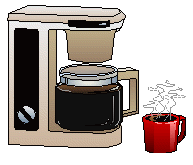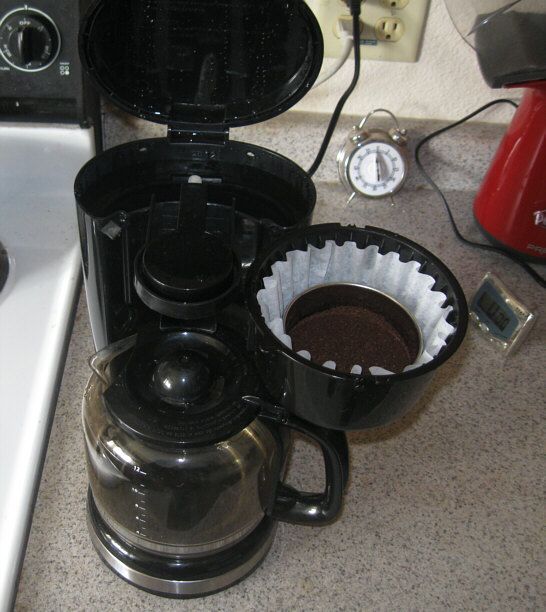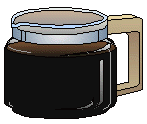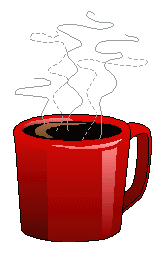 The
Making Coffee Page
The
Making Coffee Page
(The --not so-- Elusive Art of Making Good Coffee)
last worked on: March 30th, 2022 (--first posted in year 2000)
You're at: https://57296.neocities.org/coffee.htm
Fastfind: >>> Filter "flavor pores", Pre-soaking,
 The
Making Coffee Page
The
Making Coffee Page
* 2000 to 2001 was a year of assiduous research with
my good friend Chuck. Nothing seemed conclusive then, but I got the idea
that variable city water might be making a difference. I went to bottled
water ("EartH2O" brand) for years after that but gave it up
some time ago. For brewing tests, however, I think it's still a good idea
to use the same (bottled) water throughout.
![]()
March 30th, 2022 updates: Encouraged by Chuck, I tried
the "Kirkland" label coffee (a Costco house brand), finding it mild, smoother
than Folgers (despite it being available only as a "dark roast") --and
good --as good as Folgers. Apparently, it's also only available in "fine
grind" (as my local Costco outlet dealer told me), which presented a small
problem --perhaps peculiar only to me. Per:

So: I simply don't use the ring with Kirkland --and keep an eye on the filter --which the elevated steeping level promises to hold it in place (unlike with regular grind Folgers).
* A Big caveat: I'm using a slightly rounded 1/4 measuring cup of grounds for a 12 "cup" brew --for both Folgers and Kirkland. Brewed attentively (per my above suggestions), that seems/tastes to be plenty enough coffee in my coffee, even with plenty of milk and sugar, but if you follow the can's instructions, maybe you should first get a doctor's prescription.
* Kirkland says to use a "rounded tablespoon" of grounds
per (6oz) cup of brewed coffee (that might add up to 1-1/3rd cup !! of
grounds), while Folgers' advice amounts to about 2/3 cup of grounds.
![]()
February 25th, 2022 updates: I
should say a few things about temperature, milk and sugar.
* My mother and my maternal grandmother (no doubt great-grandma Segrid as well) always used percolators --and they made fine coffee. By way of maligning percolators, coffee aficionados are heard to say: "never boil coffee!". Well when reheating coffee, I've often absent-mindedly let it boil --suffering no problem with taste.
* My wife and I are in close agreement about how hot is an agreeably hot cup of coffee: 135 degrees Fahrenheit.
* I've checked our new ("Better Chef") coffee maker's keep-warm temperature (when it was half full in a rather cold kitchen): 160 degrees F --which leaves descending room for adding some milk and sugar --just right for Peggy. (I use lots of milk and sugar, so pouring coffee at 175 degrees works best for me.)
* When I first heard activity in a saucepan of reheating
coffee (with the burner element on high), the temperature measured 170
degrees F.
![]()
* Sugar and the milk fat in milk are "taste couplers"
--same as in a Hershey's milk chocolate bar. I just don't understand people
who drink coffee strong and black --unless they have to (diabetes) or it's
to fight sleep (my strong black coffee night watches in the Navy).
* My mother would start a cup with the milk
and sugar, so as not to hazard there not being room left for enough of
it. Grandma and her friends would pour coffee into the milk and sugar boiling
hot, then sit around in a little social circle (a "coffee klatch"), cup
in one hand, a bit of its hot coffee poured into the saucer held in the
other to cool it --and then to slurp it down. Great-grandma Segrid would
dip a sugar cube into her milky coffee, then suck the coffee out of the
cube.
![]()
January 11th, 2022 update:
* I failed to mention that a 12 cup coffee maker should always be used to make 12 "cups" (those are 6oz cups) --of coffee, and all coffee makers should be used at capacity. Their hot water trickles through, soaks out the coffee grounds and clogs the filter at different rates through the cycle and with time, so you want the more consistent average that comes from making full pots.
* My first pot from the "Better Chef" came out okay
but the keep-warm function let it cool too much --for someone like me who
uses a lot of milk --but it might be just right for black coffee drinkers
(ish!).
![]()
January 10th, 2022 update:
* My old Mr. Coffee looks like hell and its keep-warm plate is corroded --so I'm retired it to backup duty and I bought a new coffee maker --but:
* Our local BiMart just happened to have a big coffee maker sale going on today --but:
* ALL the coffee makers --but one-- were gussied up with digital programming buttons and displays including the cheapest ($20) Mr. Coffee (which styled itself on the packaging as being "simple").
* That exception: an On-Off switch "Better Chef" brand, 900 watt, 12 cup, model #1M-116B --and that "B" is for it having a black body, so it won't end up looking so bad (like my old white bodied, 900 watt Mr. Coffee) --but:
* Right away, I don't like it so much --took me a half-dozen tries to get at its "swing-out" basket --seemed like something might break first, thanks to tight fitting click shut locks on the lid and the basket. The Mr. Coffee has a loose, non-click-locking, lift up lid and a lift-out basket. Maybe the Better Chef would loosen up with time and use, but I hurried that up with a piece of sandpaper.
* Both coffee makers let you watch the brewing --to make sure the hot water is flooding/soaking the grounds and not just draining through (say: passed a flopped-over filter in the basket).
* Of course I first washed and ran a pot of water through the Better Chef. Hopefully that carried away a lot of the new plastic plasticizors.
* If you're in the market for a coffee maker and would
like to score an On-Off switched Mr. Coffee, try your local Goodwill, Salvation
Army, St. Benedicts and other thrift stores. Folks buy those bodacious
digital jobs, then donate their clean and functional old ones.
![]()
January 28, 2017 update:
* "If it ain't broke, don't fix it".
I'm out of bottled water again and I've go a lot of tested coffee brands siting around. Although the Folgers dark roast tastes a bit brusk, all the coffee I'm currently making tastes good/"welcome" --and it's plenty good enough using the city tap water here (although maybe not your city's).
So I'm going back to 2 heaping tablespoons of grounds
for 2 quarts of water (the 12 "cups" plus capacity of a Mr. Coffee) --and
no more testing.
![]()
Those early 2017 tests:
* Recently, Chuck detected a taste boost by simply leaving fresh coffee grounds in the basket overnight. Either that was due to "airing" the grounds, or it had something to do with the humidor effect of the grounds being exposed to the water-filled reservoir. Since I remembered an opinion that pre-soaking the grounds was a good idea (but for how long?), I was betting on the latter.
* However: I tried an "A-B" comparison of such overnight-in-the-dripolator conditioning with fresh made but could tell no difference. Both batches of coffee seemed rather "flat" (Safeway's "Signature" brand). I next tried overnighting Folgers (no "B" comparison/control this time), but the results seemed like --nothing special.
It could be that Chuck's house is a lot warmer than ours (50 degrees overnight here in winter), and that produced a higher moisture vapor content inside his dripolator.
* I brought home two gallons of EartH2O bottled water (which has consistent analyses, is reasonably hard, their well being deep enough such that radionuclides indicate a pre-WW-2 source, no chlorine of course, and about 1/3rd as much fluoride (in the form of natural calcium fluoride) --as our city water contains sodium fluoride (the much more chemically active industrial fluoride).
Fluoridation is a mandated additive for cities of population 10,000 and larger.
~~~~~~~~~~~~~~~~
No: drinking fluoridated water does not make
a difference as to dental health --unless you get too much --and then your
teeth [and bones?] get motley looking. Fluoride must be applied topically
to strengthen tooth enamel --perhaps as a toothpaste ingredient.)
~~~~~~~~~~~~~~~~
Straight away, my very subjective impression was that our coffee tasted "smoother" with that bottled water. (I was hoping it made no difference, since faucet water is a lot cheaper.)
* The next thing I tried was an actual cold water pre-soak of the grounds --for 2-1/2 hours. I passed a half cup of cold water through the grounds (and into the pot), waited the 2.5 hours, then brewed. The high humidity from the filled reservoir kept the grounds moist. That coffee was good, but not noticeably better.
* Then I did an overnight soaking of the grounds. I'd filled half the grounds basket with water. An auto-drip coffee maker (like our "Mr. Coffee") usually has a valve in the bottom of the grounds basket, so with the valve-activating lid flipped out of the way, the presoak water stays in the basket. Next morning: my coffee tasted about the same.
~ I broke down and doubled the coffee grounds I normally use: a level 1/4 cup per (2 quart) pot, but with no improvement.
~ Chuck reported he's switched to (Cosco brand) "Kirkland Supremo" dark roast with good results, so I gave that a try. (I found it locally --but it wasn't available through Amazon). To be fair, I gave Folgers' dark ("French"?) roast a try as well. As you'll see further on, dark roast is what I started with --on the assumption that good coffee was simply not available in the US of A. (Then again: maybe dark roast simply tastes better --to many of us. When I make chocolate syrup from scratch, it seems to taste better if I singe it.)
* A coffee theory: 3rd world peoples are pissing
and crapping in exports headed for imperial nations.
![]()
An update of a 2000-2001 downdate: * I've been drinking
reasonably good coffee all along: Maxwell House "French Roast" back then,
Folgers "Classic" medium roast in recent years --both of them straight
off the grocery store shelf. Maybe others would be as good, but why mess
with something that works --right? Maxwell and Folgers seem as good as
the $12/pound stuff I'd been having shipped from upstate Oregon.
* A coffee theory: The Japanese and the Arabs are outbidding the United States for the better coffees of this world.
* Another theory: As of 1997-98 (after realizing what Starbucks can get away with) the coffee brokers figure we can't tell the difference, so we're getting poor coffee for the price of the good stuff.
* If you consider the available coffee to be of poor quality, one should (of course) whine and complain, but then do what the French did, back when they were made to drink the crummy stuff that their imperial government chose to import: roast the heck out of it (ergo: "French roast"). As of the 21st Century, however, I'd backed off from that --to Folgers' "medium roast", since it seems to be better stuff. The several times they've bumped up the price and I switched to something else, taste drove me back.
* Back in 2000, I "strongly" advised brewing it using 1 level cup of grounds per two quarts of water in a standard drip machine --about twice what Folgers currently suggests. Since then, however, I backed way off (per my wife's influence) to using 1/4th as much: only a level 1/4 cup of coffee grounds to make two quarts of coffee (the actual capacity of our current "Mr. Coffee" maker --despite being graduated to "12 cups"^).
^ Be aware that a "cup of coffee" is usually considered to be 6 ounces, not a Mr. Coffee's 5+ ounce cup.
* In year 2000 I was using a Krups brand auto-drip --in lieu of my earlier, inexpensive Melitta LCM-10S coffee maker (with Melitta filters). The best filter at the time seemed to be the brown Melitta with "flavor pores" (a very deliberate move on Melitta's part, I would guess, since they'd previously prided themselves on stopping everything but the color).
Those filters seem to still be available:
> http://www.melitta.com/en/4-Cone-Filter-Paper-Natural-Brown-100-Count-1483,64752.html?scrolltoindex=6
--and this might be the current version of the LCM-10S:
> http://www.melitta.com/en/Aroma-Brew-12-Cup-Coffeemaker-66364-White-1775,64804.html
* After progressing to Folgers, however, generic, Safeway house branded ("Signature") brown filters seem to work as well. (Coffee filters usually usually pass oils and 10 to 15 micron particles.)
* My notes from 17 years ago indicate that I sought after higher wattage coffee makers for faster brewing. That indicates to me that I was --unknowingly-- trying to compensate for using too much coffee grounds. Another thought: perhaps less than "good" coffee benefits from faster brewing --extracting only the more volatile, more soluble and/or moveable "flavonoids".
* As always (your medical condition/diet allowing): I think that coffee with up to 33% milk (that's 2%, use proportionately less for whole, half-and-half, or cream) and lots of ("pure cane C&H") sugar --tastes best --or rather: has more taste, perhaps with the sharper components a bit buffered.
* Sugar and milk fat are "taste couplers" which bring out the flavor of most everything --notably: berries, fruits, dry cereal, and chocolate. I simply do not understand folks who want to drink it black.
That said: black coffee drinkers
often agreed with me as to whether a given cup of coffee is "good" or "bad".
![]()
* New Orleans style coffee with chicory
"It's what New Orleanians used to mix with their coffee
to stretch it during the civil war, but it turned out to be so good that
we stuck with it. We like it better than pure coffee. It's a slow drip
coffee where you use about 1 cup of grinds to make about 2 cups of coffee
(but) you just pour a dash of it into a whole cup of hot milk (homogenized)
to make one cup to drink... it's very strong." "The best known is the 'French
Market' brand / New Orleans Roast, but also: 'CDM' and 'Louisiana'.
(-----Thanks to Renee --who died unexpectedly :-*( *
* *
* Cuban coffee: "Beats all other coffees in the world!" --and might no longer be embargoed --per:
"There are so many Cubans here in New Orleans you can
buy cuban coffee on the shelf in the grocery --where ever they have a spanish
foods section. I don't know if it's produced here or where, but it's called
"Bustelo". Instead of grounds, it's almost a powder and you need a special
"cafeteria" to make it (available only in spanish groceries). It's served
black with a lot of sugar and almost tastes like a coffee liqueur. Delicioso!
/ Latin American Supermarkets for the Bustelo. All groceries in New
Orleans sell New Orleans style COFFEE AND CHICORY... in one or several
brands. (Thanks again, Renee ![]()
![]()
 Pre-soaking
--and how to ruin good coffee (or: not)
Pre-soaking
--and how to ruin good coffee (or: not)
* Perhaps no method of making coffee makes up for starting with poor coffee --which was (seemingly) the only kind I was able to buy back in 2000.
* On the other hand, I suspect it's pretty hard to ruin good coffee. I remember very good coffee --back in those nasty old percolator days when my family knew nothing more about making the stuff then how Grandma did it.
However, others would strongly disagree. The"Black
Bear Micro Roastery" at:
> https://www.blackbearcoffee.com/
--asserts: "Brewing a perfect cup of coffee is the
weakest link in the full enjoyment of fine coffee. Buying the finest coffee
is only the beginning and can go for naught if the brewing is not done
correctly. It is very easy to ruin otherwise excellent coffee with improper
brewing." This coffee aficionado web site raises several interesting points
and awarenesses, which I'll try to be mindful of here --but my emphases
are intended for the "plugger" --who simply wants a (remarkably) decent
cuppa, and then maybe s/he gets back to working on a project of some kind.
* At Sweet Maria's Coffee:
> http://www.sweetmariascoffee.com/forum/
--"pre-soaking" versus brew/pass-through times are
discussed at some length. While we can certainly pre-soak by adding cold
water to an auto-drip's basket, the pass-through time is determined by
the rate of percolation, the fineness of the grind and the porosity of
the filter --none of which can be adjusted (at a given time/place). So
far, I've noticed no difference with either brief or even over-night cold
pre-soaking. (On the other hand, I make fairly weak coffee, so over-extraction
might not result in the bitterness that others experience.)
* At The Coffee Project:
> http://coffeeproject.com/
--you can see a presentation of the "Brazen Coffee
Maker" --which includes an adjustable pre-soak/bloom time, the purpose
of which is to properly wet/hydrate the grounds before brewing. The time
is supposed to vary according to darkness of roast and how many days since
the roast. I'd imagine how many days since the coffee was ground (or can
opened) and how fine the grind are big factors as well --but let's not
get too deep into that stuff.
![]()
Isn't it amazing that after (what?) --a thousand years
or so, there's still so much confusion about making a good cup of coffee?
As of 2000 I thought it was because most any method use to work --then
nothing worked, but the experts and aficionados refused to admit they were
licked (and being sold crap coffee).
* So here's one alternative: drink "mocha".
It ain't coffee. It ain't hot chocolate. It's so-so to irritatingly poor coffee with the rough edges smoothed over --by way of sugar, milk and cocoa fats..
1) Pour a (good sized) mug of hot humdrum to bitter coffee.
2) Stir in 4 rounded teaspoons of cane sugar.
3) Stir in one rounded teaspoon of Swiss Miss cocoa powder.
4) Milk is optional, but advised.
![]()
Some more links:
* Kevin Sinnott's page at:
> http://www.coffeecompanion.com/
---who's long been published and sought after as an arbiter of how it's done --and with what. His apparent depth, honesty, and dedication to good coffee is quite appealing. (2017 update: Kevin's still holding forth, but it might be he's making you buy his book --in order to get at his best advice.)
* Here's another site (industry sponsored) with
solid looking information on coffee sources, health, etc:
> http://www.coffeescience.org/top10-health-benfits-of-drinking-coffee-everyday/
* Green Mountain coffee tends to dominate the top rated
brands. See them at:
> http://www.GreenMountainCoffee.com/
(You might remember that there use to be a host of
links here, but most of them bit the byte dust.)
![]()
In 1758, the Swedish botanist/master biologist Carolus
Linnaeus published his system for classifying all life --according to the
scheme: "kingdom, phylum, class, order, family, genus, species, variety"
--a succession of discernments which was drilled into me in my high school
biology class --about 60 years ago.
When it came to people, he attributed inherited as well as learned characteristics, describing "Homo European" as light-skinned and blond people who are governed by laws (oh oh). This approach lead to difficulties --which we've yet to fully recover from. The last half of the 20th century was spent in squabbling among academics as to the best way to sort us out --the issue now being even more complex on account of being able to categorize our DNA.
This culminated in a (1999/2000) formal letter of protest from the American Anthropological Society (if I have that exactly right) to the Bureau of the Census, asking why the heck we're all being made to declare our race/ethnicities when their most learned members consider such distinctions to be meaningless.
So: we are now:
* Genus: "Homo" (don't ask)
* Species: "sapiens" (knowledgeable)
* Variety "coffeaphilia" (or: those reading this web page)
What we're dealing with is the plant family "Rubiaceae",
genus "Coffea", and but two species, which account for 99% of what's sold:
C. arabica and C. robusta. Costa Rican, Colombian, and Kona are arabicas
--the varieties of coffee I'm usually talking about on this page.
![]()
My purpose in creating this page
was to:
* Find a common brand of good coffee (or mitigatably good) that you can get at the grocery store.
* Tell you how to make a decent cup of it with a drip machine.
* "Mission accomplished" as of October 8th, 2001 (with a banner flying off the quarter deck).
* --But now (2017): I'm not so sure that it was.
![]()

I disagree.
* A good quality drip coffee maker, intelligently selected, used with a measured amount of quality (brand name grocery store) coffee, in a good grade of stiff filter paper (brown/natural full height) -will match or beat all other methods of brewing coffee (in my humble opinion/experience).
It might be that paper filters aren't the best way to go. Some say they can taste the paper (or rather: the paper processing) and that one should at least flush them with hot water first.
It might be that you should use a nylon or a gold plated fine screen filter instead, but I tried that and didn't get better results. Advocates speak of "flavor particles" thus being able to get through. Detractors talk disparagingly of "sediment" contamination --implying that appropriate filtering is an essential part of the brewing process. (See Melitta's about face on that issue.)
I've tried an inexpensive Melitta brand LCM-10S coffee maker using Melitta filters with good results. Perhaps this unit is still available. (Hamilton Beach made a similar item.)
I tried Melitta's fancier ACM-10S (same funnel engineering), but it didn't let me see what was going on in the filter funnel. I think it's pretty important to know if the grind is so coarse that the water runs straight through --or that it's so fine that the filter's plugging up, making unfiltered coffee-water spill over the sides.
* After the paper coffee filter goes in, I place a thin, round, close fitting stainless steel doughnut cutter inside to make sure the filter doesn't collapse and spill over. (It's just a piece of metal --no handle.)
* All Melitta coffee makers that I've inspected have what appears to be a unique and well engineered filter funnel. If you use paper filters and no coarser than a medium "drip" grind, all the grounds seem to get covered and sampled --due to the channeling and restricted flow. There's a small reservoir in the bottom --apparently intended to catch and hold back what sediment gets through the filter ---and: that legendary last bit of "bitter, over-extracted" coffee.
My Braun screen filter worked well with "universal" grind coffee too.
* Aside from the efficiency factor of getting the grounds all wet and keeping them all involved, the other consideration for drips might be the pass-through time. One authority cites a limit of 3 minutes max. (Yes: that suggests my (year 2017) exploration of pre-soaked coffee grounds is a bad idea --but these are cold water soaks, whereas pass-through time is about hot water.)
* But: for all I know, the brewing time makes no difference --or is overshadowed by the fineness of grind. While several gourmet coffee sites admonish us about such over-brewing, another site (and Chuck's tests) suggests that "priming" coffee grounds with a pre-wet (then wait a while) sets the coffee up for proper brewing.
(Much of the advice we wade through in this life is just so much contradictory humbug.)
* I once thought that water made a big difference --and maybe it did (used EartH2O bottled instead of city water for a long while). In recent years, however, I can't detect that water makes much difference, although I'd expect that bottled spring water with some hardness and consistent character to be better --especially for running tests.
* Get a good sized coffee maker (10 or 12 "cups") (which might be only 5 oz "cups", so let's call it "two quart" capacity).
* Start with 1/4 cup of regular "auto drip" to plain "drip" grind coffee. This has to be important. For reference: I've measured samples of coarser "auto drip" grinds in the range of 1/2 to 1 millimeter in diameter. There's always quite a spread. (1/4 cup does it --if your coffee maker actually uses the grounds --by partly filling the grounds basket, but not over-flowing and spilling water over the side. Watch what's happening, to make sure.)
* Note that coffee grinder settings marked "fine" --or finer than the "auto drip" can clog and over-flow a paper filter.
* My impression is that fine ground coffee can be noticeably more bitter --other factors held constant. This might be equivalent to "over-extraction".
The finest "perc"olator setting samples I measured
run 1 to 2 mm in diameter, which allows the water to pass through my Melitta
filters a tad too fast (to involve all the grounds).
![]()
* Try to be consistent with your ingredients and measures
--such that any corrections are meaningful.
* Wait until it all brews, then turn it off --and maybe thermal carafe (a glass liner type) what you don't drink. Microwaved/"nuked" coffee is better than coffee which has been left to idle on a hot plate for hours.
![]()
 Now
comes the filter part
Now
comes the filter part
Melitta use to market their filters by stating: "[our] thicker paper traps more oils, fats, sediments". About the year 2000, however, they started to offer what appears to be the same filters, but punched full of holes ("microfine Flavor Porestm "). But the new filters were never-the-less still claimed to trap "fats, oils, and bitter sediment".
The old ones really did pass clean coffee, and the new ones aren't far behind, but it appears that a little more oil gets through, although the inside of the funnel and pot still remain relatively clean.
Whether their ad copy holds water or not, this company's at least drinking enough coffee to be wide awake and busy with innovations.
I was only using Melitta's "Flavor Pore" #4 filters back in 2000.
See other opinions at: http://www.coffeecomplex.com.au/pedia/brewingfilter.html
![]()

See also opinions at:
> http://www.wijinmusic.com/cafe-galactica/coffee.htm
![]()
* Stirring coffee: --As
you stir in sugar and *tink* the side of the cup, there'll be heard a descending
note. That's the sugar going into solution, which makes the coffee more
dense, which lowers the resonant frequency of your cuppa. When the "*tink*"
stops getting lower, all the sugar has dissolved (or: the solution is now
saturated).
![]()
 *
Too often we hurry through life, merely going through the motions. This
is a good time to relax and pay attention ("focus"). Notice and mark well
in your memory what the coffee tastes like: good, or "Good!", bad, in-between
--or maybe it's just "in-offensive"; for unless you've fixed your present
position, any course changes will be meaningless.
*
Too often we hurry through life, merely going through the motions. This
is a good time to relax and pay attention ("focus"). Notice and mark well
in your memory what the coffee tastes like: good, or "Good!", bad, in-between
--or maybe it's just "in-offensive"; for unless you've fixed your present
position, any course changes will be meaningless.
* There are many areas of life in which you can be cheap, lazy, or easy (and to advantage), but not with respect to coffee. If the coffee's mediocre, don't just leave that restaurant, club, home, job site, spouse, brand of coffee. Be a mensch/woman: step up to the plate and take charge of the brewing.
* Please don't confuse strong coffee with "Good!" coffee.
See Kevin's apt remarks at:
> http://www.coffeecompanion.com/
(Oh-oh: if you can find them. That was
16 years ago. His web site is still there, however, so dig around.)
"Good!" coffee tastes nutty-yummy, has aromatic components which play in your nose, "body", and characteristics which easily distinguish it from other brands, places of origin, roasts, suppliers, and restaurants. You should not have to wonder if it's "Good!". Upon drinking some, you'll spontaneously say "Good coffee!" --perhaps joining in chorus with everyone else in the restaurant, yapping away like seals.

* Don't go by what others say, where the coffee comes from, how much damned trouble you've gone through to brew it (or: not), what you paid for the coffee, or what you paid for the coffee maker. Go by whether or not you sit up from the dead, rapidly parroting: "*squawk!* - Good coffee! - Good coffee!"
* Always make a full pot. Coffee makers are designed to make a full pot, which is especially important with automatic coffee makers -residential and commercial --and wait for it to finish.
* Use the right amount of coffee (for you) and consistently measure it.
* Seal and refrigerate your coffee (ground or whole beans).
* Excellent coffee might issue forth from an old stained reprobate of a coffee maker, to be savored out of a scandalously discolored cup. The art is in trying to duplicate the circumstances of a "Good!" pot of coffee. (It should be obvious that compulsive cleaning and a "sterile field" might defeat that purpose.)
* It might be that only one particular person in your home or place of work can make "Good!" coffee, but no one else -even using the same coffee in the same equipment. Somehow: sandbag and Shanghai that person into becoming ship's company and assign him/her to tending the coffee mess.
* Be humble. If you can't make good coffee, have someone else make it. Only by being able to admit to such error and inadequacy might you eventually end up savoring "Good!" coffee. :-)
* Be lustilig! Do not trifle and fool with snail's pace single cup methods. Make coffee and drink it by the pot. Save for "doctor's orders", don't be a "food puritan". If you like sweet coffee, go for a saturated solution (4 tsp / 8 oz cup). If you like milk or cream, use enough of it.

I've also tried a Chemex --per the Chemex method, variations on water, coffee beans, roasts, filters, and brewing time.
* It might be that each coffee ground acts like a filter --to the coffee deeper inside that ground.
* At the very least, a finer grind vastly increases the surface area of your grounds and the extraction rate, while also increasing the pass-through time: a double whammy --so take care.
I examined Yuban's grind "for all coffee makers", the out put of a commercial Bunn grinder set to Drip (a "Mr. Coffee" symbol on the setting), and a friend's favorite "grind" --as outputted by a cheap little blender-blade type bean grinder.
As you might expect, the blender grinder's coffee grounds had a wide range of sizes (all 3 samples did), but it seemed easy to say that they averaged a millimeter (40/1000 of an inch) in diameter --and so did the Yuban grounds. The "Drip" grind looked to average about half of that --and was too fine/slow for gravity filtration through a paper filter by hand (ie: with you standing there pouring hot water --like a dummy).
Drip grind worked fine, of course, with a Braun screen filter, vacuum assist filtration, and with immersion brewing (the "stove top method").
Some people are not aware that coffee "strength" (and caffeine kick) is proportional to how fine the coffee is ground. If all you cared about was strength, you might use "espresso" (finest) ground coffee and a vacuum pot (but best add a little disk of paper filter under the built-in filter). Unfortunately, over-extraction can produce bitterness.
The experience to date is that fine ground coffee is not only stronger, it also tends to range from sharp, to harsh, to bitter --and without really improving the flavor. (I think of coffee "flavor" in terms of aromatics, "nuttiness", "body", "wholeness", etc.).
* Don't buy flavored coffee. Federal Marshals and DEA agents should be hunting down people "holding" such substances. (You can just pour in a little OJ or add a dab of cinnamon at home if you like. Two or 3 cups of that will probably be enough for some long while.)
* Don't buy coffee that's advertised as XX% "less"
--anything.
![]()
Organic Coffee:
If you're young enough to have a lot of miles left on the odometer, or if you care about younger people who drink your coffee, you might concern yourself with the outrageous practices of international corporate food conglomerates --what they're doing to food and to us general.
At the consumer/retail level, the trick is to find certified organic food --at affordable prices.
It's mostly up-scale types of folks who can afford not to eat corporate food --but my web pages are more for us "pluggers" and bottom feeders. Only a relatively few of us will be able to buy our way out of the impending food supply and ecological disasters (brought on by the likes of Monsanto and deregulators like President Trump).
Of course, our only long term hope is to get some population control, reduce the influence of blind corporate greed on elections and government, to vote for "Green Party" type candidates and issues.
 In
memory of Florence Fone
In
memory of Florence Fone